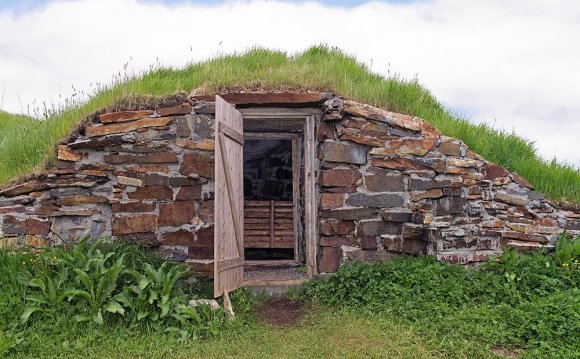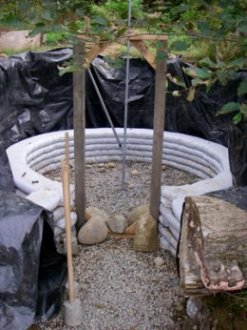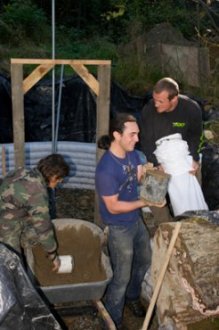
 By Steve Nicolini
By Steve Nicolini
We have finally completed our 4 years-and-running earthbags building project. We wanted a natural cold storage for all of the root crops we grow here in the western foothills of Washington’s Cascade Mountain range.
This is a wonderful alternative to conventional construction. They are much less expensive and much more ecologically friendly.
The story of our earthbag root cellar begins with a man who loved to dig. This man could often be found digging the hole for our root cellar. The sound of his shovel and pickaxe would only be drowned out by his grunts and groans as he dug deeper and deeper into the earth, pulling out gigantic rocks (that would one day edge our garden beds).
 The man’s perseverance and work ethic was so inspiring I decided to jump in. One day, we were throwing shovels full of dirt from the 8 ft. deep x 11 ft. wide hole in the ground when the man said, “Okay. That is deep enough.” It was time to review our notes on building with earthbags and design our cellar.
The man’s perseverance and work ethic was so inspiring I decided to jump in. One day, we were throwing shovels full of dirt from the 8 ft. deep x 11 ft. wide hole in the ground when the man said, “Okay. That is deep enough.” It was time to review our notes on building with earthbags and design our cellar.
The materials needed:
- Earthbags (enough to complete your structure)
- Barbed wire
- Strong wood for door/window forms
- Drainage and foundation material (we used gravel and perforated pipe)
 - Some straight pieces of wood or metal or plastic to make a compass.
- Some straight pieces of wood or metal or plastic to make a compass.
- Baling twine
- Tampers (full pounders and quarter pounders)
- Levels
- Measuring tapes
- Big Old Coffee cans
The first thing we did was lay out the drainage and foundation, which are essential for any structure. Around the outside of the bottom of the hole we laid a 4 in. perforated pipe on a 4% grade down and out of the structure. We then dumped in a 1 ft. depth of large rounded gravel and tamped it to level. This gravel would be our foundation and our floor.
The next step was to find the exact center of our round structure-to-be and set our compass. We used some old chain link fence parts with an L-bracket lashed onto them to make our compass. It was essential for creating a perfectly round structure. It also aided us in the decrease in radius with each rising course of earthbags.









